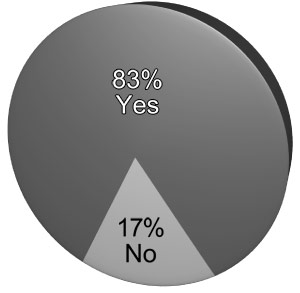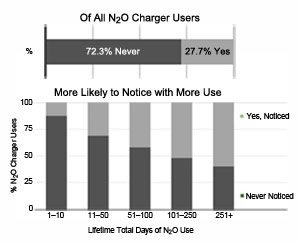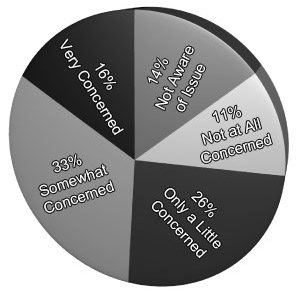N2Oily
Nitrous Oxide Chargers--Residue and Usage Surveys
Nov 2009
Citation: Erowid F, Erowid E. "N2Oily: Nitrous Oxide Chargers--Residue and Usage Surveys." Erowid Extracts. Nov 2009;17:12-14.
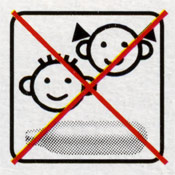
|
In 2008, a new filter product called NitroKit was released that claims to remove "any possibility of taste or impurity" due to contaminants present in chargers. 1 We decided it was time to revisit the question of contaminants that might affect recreational users of N2O.
In September and October of 2009 we conducted a series of micro-surveys on Erowid.org about the recreational use of nitrous oxide, and ran some informal experiments to investigate the black residue from chargers. The question of contaminants in the gas stream is relevant to Erowid visitors because 66% of respondents to our surveys had tried N2O at least once, and almost 50% of those who had tried it in the form of whipped cream chargers reported using an average of more than six chargers per occasion of nitrous oxide use.
Though our experiments should be replicated more formally to verify and quantify the results, it was very clear that an oily residue containing tiny black flakes and shards of metal was present in the nitrous oxide stream that would be inhaled from a WCM. While the NitroKit filter helped reduce the amount of residue by a small amount, it was not a dramatic reduction. A simple piece of cloth over the output seems to be an effective method for filtering out most of this residue.

|
Purpose of Experiments
The experiments were designed to confirm the presence of oily residue in multiple brands of nitrous oxide chargers; to determine whether the residue is present in the stream of gas dispensed from a whipped cream maker; to test whether the use of the NitroKit filter is an effective method of reducing the residue in the output stream; and to attempt to quantify the amount of residue in chargers.Materials
All tests used the same iSi brand half-pint whipped cream maker.In the first two tests, we used an equal number of two brands of nitrous oxide chargers, Pure Whip and EZ-Whip, in order to ensure we would find some residue. Pure Whip's white-painted chargers are manufactured in Hungary. EZ-Whip's silver chargers are manufactured in the Czech Republic. For the third test, we used exclusively iSi brand purplish-metallic chargers, manufactured in Austria, reputed to be cleaner than others.
The NitroKit is a two-inch-long extension that attaches between the charger and the WCM on the input side. It contains a small black filter that, according to the manufacturer, is made with activated charcoal. We purchased one NitroKit filter kit with extra filters from the manufacturer, but were sent two additional kits when the manufacturer learned we were writing a review.
Our output filter was constructed of clean squares of new white cotton "flour sack" kitchen towel material, folded so that each filter had four layers.
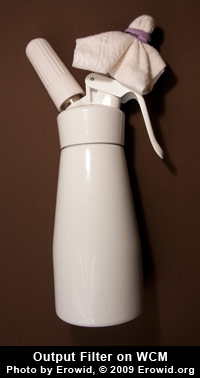
|
Methods
Three main tests were conducted. Each test used an output filter attached to the nozzle of the WCM using a rubber band. The WCM was held upright during testing, with the output nozzle above the main chamber.Test A attempted to document and quantify the amount of residue dispensed after running 144 chargers through the WCM (72 Pure Whip and 72 EZ-Whip). Test B was identical to the first, but added the NitroKit pre-filter between the nitrous oxide charger and the WCM. Test C used 144 iSi brand chargers and, as with test A, did not use the NitroKit pre-filter.
During each test, the cotton output filter was examined after 6, 12, 24, 48, 96, and 144 chargers. The cotton output filter was weighed before and after each test. Then, after each test, a clean paper towel was weighed and used to thoroughly wipe out the inside of the WCM. The paper towel was then weighed again.
The output filters and paper towels were examined using a 10-30x Bausch and Lomb industrial microscope, and photographs were taken of all materials and stages of the process. Weighing was conducted using an Acculab V1-mg, recently calibrated, with 1 mg readability and +/- 3 mg repeatability.
Because cracking a N2O charger induces rapid cooling, quickly running more than four to eight chargers in a row caused the valve mechanisms to freeze up and the WCM to become uncomfortably cold to the touch. In order to better match ordinary practice, a maximum of eight chargers were cracked in a short period, then the WCM was allowed to warm up before more chargers were opened.
Results
The primary findings from this experiment were:
- A dark-colored residue is present in the gaseous output from a whipped cream maker used to dispense nitrous oxide, both with and without the use of a NitroKit input filter. That residue is made up of a yellowish or grey oil, a large number of black particles of unknown material ranging in size from dust to 2 mm across, and shiny metallic fragments ranging in size from dust to 3 mm long.
- Residue from as few as six chargers was visible to the naked eye (but somewhat hard to see) as a yellow or grey stain on the output filter. Magnification was generally necessary to see metal fragments from a small number of chargers. After twelve or more chargers, black flakes and metal fragments became visible to the naked eye in bright light, both inside the WCM and on the output filter.
- Residue was present in all three brands tested: EZ-Whip, Pure Whip, and iSi. Amounts of residue were similar across all three brands, though the residue from the iSi chargers was grayer in color than the EZ-Whip and Pure Whip brand residue, which was more yellowish-brown.
- The NitroKit input filter reduced the total amount of residue present in the output gas, but only by a small amount. Two observers estimated that there was approximately 10-20% less residue with the NitroKit filter than without.
- A single layer of cotton filter on the output nozzle caught around 95% of the residue and three layers caught virtually all residue. Even under magnification, no residue was visible on the fourth layer of the output filter.
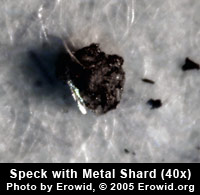
|

|
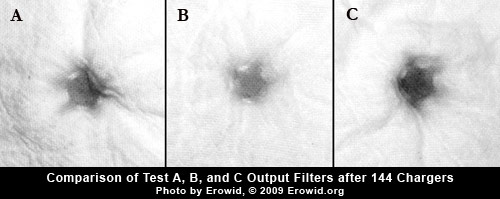
|
Mass of Residue
Weighing the paper towel that was used to collect residue from the WCM after 144 chargers resulted in 120 mg of residue after test A (without an input filter), 110 mg of residue after test B (with the input filter), and 120 mg of residue after test C (iSi brand). Unfortunately, the experimental design and environmental changes led to inconsistent results when measuring the small quantities of residue left on both the NitroKit input filter and the output filter cloth. We were unable to get accurate and consistent readings of the weight of the deposits on these filters.
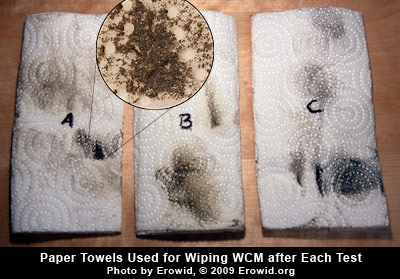
|
NitroKit Comments
The NitroKit consists of a small replaceable filter disk plus three plastic components, two which hold the filter between them, and one which appears identical to the standard charger holder/cap that comes with a WCM. The component's plastic seemed slightly too weak for the application, and a crack formed in the cap during our tests. Another NitroKit user has reported that his cap cracked and broke after about 600 chargers. The manufacturer said they were working on a redesign, perhaps making components out of metal. One minor annoyance is that, when loosening the charger holder each time a new charger is inserted, the lower two parts of the NitroKit can unscrew, leading to some gas leakage. This could have been more of an issue for us than for the average user, since we were replacing chargers repeatedly and very quickly.
The input side of the filter disk quickly develops an indentation where the gas hits it and the downstream side bows out slightly. Some metal flakes were caught by the NitroKit filter and were visible on the side of the filter towards the charger, making it important to keep it in the same orientation if it is removed and reinserted.
Though the NitroKit.com website suggests that the black flakes that accumulate in the WCM are "carbon powder", 2 they provide no citation for that claim. NitroKit describes its filters as "activated carbon", which is a material designed to capture extremely small particles. However, the impurities in nitrous oxide chargers appear to be significantly larger and more abundant than the filter can handle.
More Questions
This experiment is just a beginning and raises additional questions. First, the composition of the residue should be identified. Second, since it is popular to inhale nitrous oxide using a cracker and balloon, a similar experiment should be run with that setup. We also hope to test whether output residue levels are different when using a larger capacity WCM or a compatible soda siphon. Other practical methods might reduce the amount of residue in the output stream, such as placing a loose cloth inside the WCM, though this could propel cloth fibers into the output. A long, flexible tube on the WCM output nozzle might capture more of the residue and/or lower gas velocity enough to reduce the amount of inhaled particles.
The most practical product would filter the gas as it is dispensed from the whipped cream maker, but this might be considered illegal paraphernalia in some jurisdictions, since it would be useful for inhaling N2O but not for making whipping cream. A more effective filter system could be designed that sits between the cartridge and the WCM (and therefore would not be specific to inhalation use). This might include a more tortuous path, a much thicker/longer filter, or a pre-expansion chamber to reduce contamination in both whipped cream and lungs.
Perhaps our most interesting conclusion is that a simple piece of cotton cloth, such as a t-shirt or kitchen towel, placed over the output nozzle at the time of inhalation, is an easy and effective method of filtering out nearly all of the residue discharged from whipped cream chargers.
| N2O Use Surveys | |||
About two-thirds of survey respondents had tried inhaling nitrous oxide recreationally and about four out of five of those had used whipped cream chargers as their source at least once. Presumably the rest used nitrous either from pre-filled whipped cream cans or from a refillable cylinder ("tank") of gas. Around half of those who had used a charger reported most often opening it with a whipped cream maker (WCM), and half reported most often using a "cracker" (a small device designed to open a charger and release the gas into a balloon or bag). Additional data showed that more than half of those who had ever used nitrous oxide had not used it in the past year. On the other end of the spectrum, around 7% reported having used nitrous oxide more than twice in the last month. The following results leave out respondents who stated that they didn't know the answer to a question or preferred not to answer.
Number of Use Occasions
Of 11,320 respondents, 66.3% reported having inhaled nitrous oxide recreationally and 33.7% said they had not. Of those who had tried N2O, 48.5% had tried it 1-10 times, 26.5% had used it 11-50 times, 10.7% had used it 51-100 times, 6.0% had used it 101-250 times, and 8.3% reported having used it on more than 250 occasions.Use of N2O Chargers
83.0% of those who had tried nitrous oxide had used chargers as a source. Of those who had used chargers, 47.0% most often opened them with a "cracker" and dispensed the N2O into a balloon. 34.4% most often opened the charger into a WCM from which they directly inhaled the gas, 11.2% most often used a WCM with a balloon, 1.7% most often used a cracker with a bag instead of a balloon, 0.7% usually used a WCM and bag, and 0.5% most often used another unspecified method.Number of Chargers Used
Of those who had used chargers, 54.5% said they used an average of 1-6 chargers in a day of use. 14.3% reported an average of 7-12 chargers, 14.8% an average of 13-24, 10.9% an average of 25-48, and 6.0% reported an average of more than 48 chargers used in a day of nitrous oxide use.Most Chargers Used
Of those who had used chargers, 32.8% reported that the maximum number they had used in a day of use was 1-6 chargers. 15.1% reported using a maximum of 7-12 chargers, 15.9% reported using a maximum of 13-24, 15.0% had used a maximum of 25-48 chargers, 9.9% had used a maximum of 49-96 chargers, and 5.6% reported having used more than 96 chargers in a single day.
Recent Days of Use in Last Year
Of those who had ever used nitrous oxide recreationally, 29.2% had used it in the last month; 73.0% of respondents had used N2O in the last year, with 23.5% saying they had used it only 1-2 times in the last year and on the opposite end, 0.5% saying they had used it on more than 200 occasions in the last year.Are Users Aware of Residue?
Among those who had used N2O chargers, 27.4% report that they had noticed "dirt, grime, or residue" in balloons or whipped cream makers used with nitrous chargers, while 72.3% had never noticed such residue. Those who reported having used nitrous more times were more likely to report having noticed the residue. Of those who had noticed the residue, 48.3% were "somewhat" or "very" concerned.Does "Grime" Affect Purchasing?
Of those who had used chargers and had noticed residue, 36.6% said that they "almost always" or "always" considered the grime when selecting a brand of chargers to purchase. 42.8% who had noticed the residue had "never considered" or had "not usually considered" the grime when making a brand selection. 6.6% had never personally purchased chargers and 12.7% reported that they'd never had a choice of brands. |
References #
- Creamright.com. (Manufacturers of the NitroKit). "NitroKit N2O Piercing and Filtering System". Accessed Oct 10, 2009. Creamright.com/category/nitrokit.html.
- NitroKit.com. "NitroKit Wholesale Information". Accessed Oct 10, 2009. Nitrokit.com/info.html


